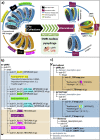qMRI-BIDS: An extension to the brain imaging data structure for quantitative magnetic resonance imaging data
- PMID: 36002444
- PMCID: PMC9402561
- DOI: 10.1038/s41597-022-01571-4
qMRI-BIDS: An extension to the brain imaging data structure for quantitative magnetic resonance imaging data
Abstract
The Brain Imaging Data Structure (BIDS) established community consensus on the organization of data and metadata for several neuroimaging modalities. Traditionally, BIDS had a strong focus on functional magnetic resonance imaging (MRI) datasets and lacked guidance on how to store multimodal structural MRI datasets. Here, we present and describe the BIDS Extension Proposal 001 (BEP001), which adds a range of quantitative MRI (qMRI) applications to the BIDS. In general, the aim of qMRI is to characterize brain microstructure by quantifying the physical MR parameters of the tissue via computational, biophysical models. By proposing this new standard, we envision standardization of qMRI through multicenter dissemination of interoperable datasets. This way, BIDS can act as a catalyst of convergence between qMRI methods development and application-driven neuroimaging studies that can help develop quantitative biomarkers for neural tissue characterization. In conclusion, this BIDS extension offers a common ground for developers to exchange novel imaging data and tools, reducing the entrance barrier for qMRI in the field of neuroimaging.
© 2022. The Author(s).
Conflict of interest statement
The authors declare no competing interests.
Figures


Similar articles
-
Microscopy-BIDS: An Extension to the Brain Imaging Data Structure for Microscopy Data.Front Neurosci. 2022 Apr 19;16:871228. doi: 10.3389/fnins.2022.871228. eCollection 2022. Front Neurosci. 2022. PMID: 35516811 Free PMC article.
-
MEG-BIDS, the brain imaging data structure extended to magnetoencephalography.Sci Data. 2018 Jun 19;5:180110. doi: 10.1038/sdata.2018.110. Sci Data. 2018. PMID: 29917016 Free PMC article.
-
An Automated Tool to Classify and Transform Unstructured MRI Data into BIDS Datasets.Neuroinformatics. 2024 Jul;22(3):229-238. doi: 10.1007/s12021-024-09659-5. Epub 2024 Mar 26. Neuroinformatics. 2024. PMID: 38530566
-
[Computational neuroanatomy and microstructure imaging using magnetic resonance imaging].Nervenarzt. 2017 Aug;88(8):839-849. doi: 10.1007/s00115-017-0373-4. Nervenarzt. 2017. PMID: 28721539 Review. German.
-
Advances in MRI-based computational neuroanatomy: from morphometry to in-vivo histology.Curr Opin Neurol. 2015 Aug;28(4):313-22. doi: 10.1097/WCO.0000000000000222. Curr Opin Neurol. 2015. PMID: 26132532 Review.
Cited by
-
Open and reproducible neuroimaging: From study inception to publication.Neuroimage. 2022 Nov;263:119623. doi: 10.1016/j.neuroimage.2022.119623. Epub 2022 Sep 12. Neuroimage. 2022. PMID: 36100172 Free PMC article. Review.
-
The relaxometry hype cycle.Front Physiol. 2023 Nov 9;14:1281147. doi: 10.3389/fphys.2023.1281147. eCollection 2023. Front Physiol. 2023. PMID: 38028766 Free PMC article.
-
Reproducible Research Practices in Magnetic Resonance Neuroimaging: A Review Informed by Advanced Language Models.Magn Reson Med Sci. 2024 Jul 1;23(3):252-267. doi: 10.2463/mrms.rev.2023-0174. Epub 2024 Jun 19. Magn Reson Med Sci. 2024. PMID: 38897936 Free PMC article. Review.
-
ezBIDS: Guided standardization of neuroimaging data interoperable with major data archives and platforms.Sci Data. 2024 Feb 8;11(1):179. doi: 10.1038/s41597-024-02959-0. Sci Data. 2024. PMID: 38332144 Free PMC article.
-
Reproducible Spinal Cord Quantitative MRI Analysis with the Spinal Cord Toolbox.Magn Reson Med Sci. 2024 Jul 1;23(3):307-315. doi: 10.2463/mrms.rev.2023-0159. Epub 2024 Mar 12. Magn Reson Med Sci. 2024. PMID: 38479843 Free PMC article. Review.
References
-
- Markiewicz, C. J. et al. OpenNeuro: An open resource for sharing of neuroimaging data. bioRxiv, 2021.2006.2028.450168, 10.1101/2021.06.28.450168 (2021).
Publication types
MeSH terms
Substances
Grants and funding
LinkOut - more resources
Full Text Sources
Medical

